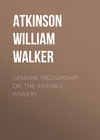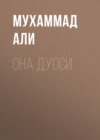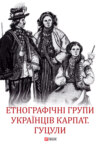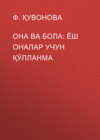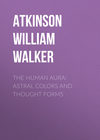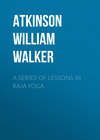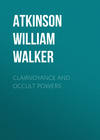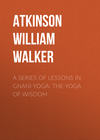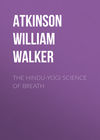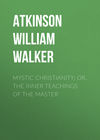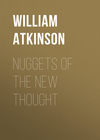Kitabı oku: «Genuine Mediumship; or, The Invisible Powers», sayfa 12
PART VII
MEDIUMISTIC CONDITIONS
Mediumistic phenomena, i.e., the phenomena by and through which spirits manifest their presence and demonstrate their power, may be broadly classified under two heads, as follows, (1) physical phenomena, and (2) mental phenomena.
Physical Phenomena
Physical Phenomena cover a wide range of mediumistic manifestations, among which are movements of tables, the production of "raps," the manifestation of spirit lights, freedom from the effects of fire, the passage of matter through matter, direct writing upon paper or upon slates, direct voices, levitation of the medium, spirit photographs, and the production of the materialized form of the spirit. While in rare cases the spirits may manifest these forms of physical phenomena without the assistance of the medium and the circle, nevertheless as a rule such phenomena are produced by the spirits only through the assistance of a medium, and usually only when there is gathered together a circle.
"Psychic Force."
Various explanations of the power employed by the spirits, assisted by the medium and by the circle, have been offered by the scientific investigators of the subject. The most generally accepted theory of the western scientists is that the spirits employ what is called the "psychic force" of the medium, often assisted by that drawn from the circle and focused in the medium. The medium is regarded as a psychic storage battery which is freely drawn upon by the manifesting spirit. The degree and character of the manifestations are determined largely by the peculiar quality of the psychic force, the capabilities of the medium, the knowledge and powers of the spirits, and the influence of the sitters.
Human Magnetism
Dr. Dean Clarke says: "Human magnetism, or nerve aura, is probably the most sublimated form of ethereal matter, hence nearest in refinement to spirit substance, and therefore spirits use it as the vehicle of their vibrating forces. Those persons who have an excess of magnetism, of the proper quality to unite with both the psychic force of spirits and the forces inherent in natural objects, and thus form an electro-magnetic connection of spirits with the objects they wish to act upon, are the persons chosen by the spirits for physical mediums. The mind and brain of the medium are not often nor necessarily controlled, and only his magnetism and psychic forces are used, through which the spirits transmit the vibrations of their own power to mechanically produce concussions, or movements of material objects."
"Zoether."
Hudson Tuttle (writing under control) gives the following statement of a spirit concerning the manner in which physical phenomena are produced: "Zoether (psychic force) emanating from the medium charges the object to be moved, and a band of spirits directs a current of their own zoethic emanation in the direction they desire the article to move, and it passes along the current thus produced. The charging of the object by the medium is necessary in order that it may be in a state of vibration harmonious to the spirit current. If this current be directed against the table or other charged body, raps or concussions are produced, as a positive and negative relation exists between the spirits and the medium's zoether. One spirit alone cannot produce physical manifestations. If one purports to communicate, assistance will be rendered by many others, who combine their influence."
"Prana."
The orientals account for physical mediumistic phenomena in a similar way, though their terms are different. Instead of speaking of zoether, or psychic force, they always employ the term "prana." In the oriental philosophies "prana" is explained as a subtle form of energy permeating the universe, but manifesting in a special form in the organism of the human being. This subtle force, or prana, is held to be capable of being transmitted from one organism to another, and is held to be the energizing power by means of which many forms of occult or magic phenomena are produced. Prana is very much akin to the "human magnetism" of the western occultists, and the properties attributed to the latter are really those which the orientals for centuries past have held to be among the essential properties of prana; so, at the last, there is found to be a practical agreement here between the oriental and the western schools of occultism, respectively, in spite of their differing terminology.
Mental Phenomena
Mental Phenomena cover another wide range of mediumistic phenomena, among which may be mentioned the following, viz., involuntary or automatic writing and drawing, writing by means of the planchette or "ouija" board or similar mechanical aid to writing, clairvoyant perception of spirits, clairaudient hearing of spirit voices, prophetic utterances of spirits, impersonating and inspirational control of the medium. Mediums are frequently so thoroughly "under the influence or control," especially in private circle seances, that they seem to have been transformed into another personality. Sometimes the medium through which the spirit is manifesting will have his facial appearance changed so completely that persons present will recognize in the changed appearance the looks of the spirit as known when it was in earth life.
The Value of Phenomena
The chief value of physical mediumistic manifestations is not, as generally supposed, that of affording entertainment or food for thought for those witnessing them, but rather that of affording proof of the possibility of spirit communication, particularly when spirit identity is established through the manifestation of the phenomena. A writer says of this class of phenomena: "A good psychographic medium will usually obtain writing between closed slates, which may be brought by the investigator, who can insist upon their not leaving his sight, and not even leaving his hand. We have obtained writing on paper that we had previously marked, which was then covered by our own hand, and a friend's and was untouched by the medium. On another occasion, a slate which we had personally cleaned was laid on the floor (fully six feet from the medium) with a small piece of pencil under it (in broad daylight), and on taking it up shortly afterwards there was found written on the under side a long message of a private nature from a deceased friend, of whom we were not thinking. Such phenomena as these are still good and impressive, they cannot be counterfeited under like conditions, and even when no proof of identity is given in connection with the writings, they point so distinctly to the action of a discrete, disembodied intelligence as to compel the recognition of their spiritual origin. The evidential utility of physical phenomena lies in their being inimitable by fraud. Imitations can of course be made which might satisfy the credible and the gullible, but the conditions for testing the phenomena we have specially referred to are so simple that no rational investigator need be deceived; first, to be sure that the slate, paper, or panel to be used is perfectly blank; second, that it does not leave the hand of the inquirer, or if it does, that it is marked in such a way that there can be no doubt of its identification when it is returned to him; and thirdly (with paintings), to observe if the paint be wet, and note the time occupied in their production."
Trance Condition Not Essential
Many persons are under the impression that it is necessary for a medium to go into the trance condition in order to manifest physical mediumistic phenomena, but such is not the case. While many mediums do lapse into the trance conditions at such time, it is equally true that many others do not do so. Some of the very best mediums produce some of the most striking manifestations while in a perfectly normal, waking condition. A writer says of a well-known medium: "She constantly receives evidences of the presence of her spirit friends while she is perfectly normal. We have heard rappings and witnessed movements of physical objects in her presence, while holding friendly conversation with her, when we have been in a good light. Frequently, at meal times, the spirits announce their presence by raps, and respond to the salutations and questions of their medium and other members of the family."
Professor Loveland says: "Many of the best mediums in the world were never entranced in the sense of being in an unconscious sleep. And it is doubted whether that condition is desirable. The Fox girls, and most, if not all of the original rapping mediums, were never in the deep sleep trance. It is not necessary for any of the physical manifestations, and that includes a very large percentage of all the spirit phenomena. The rappings, tippings, movings, slate writings, automatic writings, paintings, telegraphing, voices, materializing, etc., can all occur without the sleep trance, the reason for which is very apparent, as in the production of such phenomena the spirits simply use the surplus radiated nerve-force of the medium."
Scientific Reports on Phenomena
Sir William Crookes, in speaking of D. D. Home and Euspasia Paladino, said: "Most, if not all, of the occurrences with Euspasia seem to have taken place when she was in a trance, and the more complete the trance the more striking the phenomena. This was not always so with Home. Certainly the two most striking things I ever saw with him, the fire test and the visible forms, were to be observed while he was entranced, but it was not always easy to tell when he was in that state, for he spoke and moved about almost as if he were in his normal condition; the chief differences being that his actions were more deliberate, and his manner and expressions more solemn, and he always spoke of himself in the third person, as 'Dan.' When he was not in a trance we frequently had movements of objects in different parts of the room, with visible hands carrying flowers about and playing the accordion. On one occasion I was asked by Home to look at the accordion as it was playing in the semi-darkness beneath the table. I saw a delicate looking female hand holding it by the handle, and the keys at the lower end rising and falling as if fingers were playing on them, although I could not see them. So lifelike was the hand that at first I said it was my sister-in-law's, but was assured by all present that both her hands were on the table, a fact which I then verified for myself."
Phenomena Without Darkness
"Home always refused to sit in the dark. He said that, with firmness and perseverance, the phenomena could be got just as well in the light, and even if some of the things were not so strong, the evidence of one's eyesight was worth making same sacrifices for. In almost all the seances I had with Home there was plenty of light to see all that occurred, and not only to enable me to write down notes of what was taking place, but to read my notes without difficulty. Home was very anxious to let everyone present be satisfied that he was not doing any of the things himself—too anxious, I sometimes thought, for frequently he would interfere with the progress and development of what was going on by insisting that some sceptic or other should come around and take hold of his hands and feet to be sure he was not doing anything himself. At times, he would push his chair back and move right away from the table when things were moving on it, and ask those furthest from him to come round and satisfy themselves that he had nothing to do with the movements. I used frequently to beg him to be quiet, knowing that, if he would not move about in his eagerness to convince us of his genuineness, the strength of the phenomena would probably increase to such a degree that no further evidence would be needed that their production was beyond the powers of the medium.
Test Conditions
"During the whole of my knowledge of D. D. Home, extending for several years, I never once saw the slightest occurrence that would make me suspicious that he was attempting to play tricks. He was scrupulously sensitive on this point, and never felt hurt at anyone taking precautions against deception. He sometimes, in the early days of our acquaintance, used to say to me before a seance, 'Now, William, I want you to act as if I were a recognized conjurer, and was going to cheat you and play all the tricks I could. Take every precaution you can devise against me, and move about and look under the table or where else you like. Don't consider my feelings. I shall not be offended. I know that the more carefully I am tested the more convinced will everyone be that these abnormal occurrences are not of my own doings.' Latterly, I used jokingly to say to him, 'Let us sit round the fire and have a quiet chat, and see if our friends are here and will do anything for us. We won't have any tests or precautions.' On these occasions, when only my family were present with him, some of the most convincing phenomena took place."
Is Darkness Necessary?
From the above it is seen that not only is the trance condition not absolutely necessary for the production of striking mediumistic phenomena, but that, also, there is no absolute necessity for the condition of darkness to be maintained as an essential feature of such phenomena. While many mediums insist upon the condition of darkness at seances, it is thought by some careful thinkers that this arises from the fact that such mediums have been accustomed to such conditions from their earliest days of mediumship, and have grown to believe that the same are absolutely necessary. It is thought that if such mediums would begin over again, practicing in full light in the company of a few sympathetic friends, they would before long grow accustomed to the new conditions, and would then be able to reproduce all of their most important phenomena in full light. Using the terms of modern psychology, it would seem that such mediums are the victims of their own "auto-suggestion," and fixed beliefs; and, as all students of the subject well know, the mental states of the medium have a most important bearing of the quality of the phenomena produced, and form a very important factor of the conditions governing the success of the seance.
Developing Circles
The person who is developing mediumship will do well to surround himself with persons of a certain type of psychical power, and to form circles of such persons. Such persons are invaluable in constituting a "developing circle." Such persons need not be mediumistic themselves, nor are they required to actually do anything. Instead, their service is that of being present as psychical reservoirs of force upon which the spirits can draw for manifesting power. The medium, being sensitive to helpful influences, and the reverse, will recognize such persons by the congenial and harmonious influence they exercise upon him; and he will do well to encourage such persons to sit in his developing circles.
Impersonating Mediumship
What is known as "impersonating mediumship" occurs where the medium is so completely under the control of the manifesting spirit that he will exhibit, often in a marvelously accurate manner, the personal characteristics and mannerisms of the spirit, and which are readily recognized as such by the spirit's surviving friends in earth-life. Sometimes the medium will actually re-enact the dying moments of the controlling spirit. In many cases such impersonations have been so nearly photographically and phonographically correct that they have afforded the most convincing proof to investigators, and in other cases have been a great consolation to relatives of the spirit who have been thus assured that their loved one was still in actual existence on a higher plane of being. These results, however, are possible only when a very close rapport condition has been established between the spirit and the medium. In cases in which such a close rapport condition is obtained, and a high degree of harmony developed, the spirit will be able to positively establish his identity by causing the medium to utter his exact words, and to give names, dates, and close details of incidents occurring in his earth life, and often to employ his exact set phrases and verbal tricks of speech, so as to bring to the consciousness of the sitters the realization that they are in the actual presence of the decarnate spirit friend.
The Proper Mental Condition
The young medium, however, should beware against striving too hard to be the instrument of the phenomena of spirit impersonation. For a too intense anxiety, and desire to please sitters, frequently tends to produce a cloudy mental state in which the ideas in the mind of the medium blend with the spirit communication, and thus produces a most unsatisfactory result, and one which is apt to confuse the minds of the sitters and sometimes actual arouse suspicion that the medium is trying to practice deception. For this reason the young medium should not seek the attendance of persons desiring "test seances;" at least, such should be his course until he has learned not to be carried away with his desire to please or to satisfy such persons attending his circles. He should endeavor to cultivate a mental condition of calmness, and a determination not to influence or to interfere with the spirit communications in any way whatsoever, but, instead, to allow himself to become a passive instrument for the communication. The medium should remember that he is not a dealer in merchandise "warranted to please," but is, instead, a medium of communication between the spirit and those still in earth-life.
Demand Proof of Spirit Identity
A certain degree of care and caution, and the employment of honest powers of discrimination, is necessary on the part of the sitters in cases of spirit impersonation. This not because of any lack of honesty on the part of the medium, but because of the habit of a mischievous class of dwellers on the planes of spirit life to falsely impersonate other spirits as such seances. As all investigators of the subject know very well, it is not an infrequent thing for such mischievous and meddlesome spirits to endeavor to pass themselves off as the relative or friends of those in the circle, or even to falsely impersonate some great historical personages. In such cases the sitters should insist upon the spirit positively identifying himself, just as they would in case of doubt regarding a person speaking to them over the telephone and claiming to be such-and-such a person. And the proof demanded should be similar to that which would be sought from the suspected telephone talker. An honest spirit communicator does not object to such demands, and is only too ready to do his best to furnish the right kind of proofs concerning his identity.
The "Trance Condition."
The psychic condition frequently attending the demonstration of mediumship powers is usually spoken of as a "trance," but this term is quite misleading, for it carries with it the suggestion of an entire loss of consciousness and of a condition of more or less deep sleep. But the mediumistic trance is seldom a deep sleep condition. Instead, it is the condition similar to that of a profound "day dream," in which the person is fully awake but in which the consciousness has been almost entirely taken off the sights and sounds of the outside world. As a writer has well said: "What is called 'trance mediumship' is seldom of the nature of the deep sleep of entire unconsciousness. It is more frequently the suspension of the ordinary consciousness of external surroundings, a temporary oblivion on the outer plane—a semi-conscious state, in fact—in which the subject does not retain the volitional ability to employ his thinking powers, the latter having been 'switched off,' so to speak, and the subject responds to the will of the spirit control."
Spirit Inspiration
Wallis says, concerning the nature of a certain phase of spirit control: "In the case of speaking mediumship, where general and philosophical ideas are to be transmitted, the control is of a different order from that exercised for test manifestations. It is more frequently of the nature of 'suggestion.' The spirit suggestionist suggests to the medium a certain train of ideas, and then stimulates the brain and the organs of expression to do the work of dressing up the thoughts and giving them utterance. Unless the subject is a scientific or a biographical one, in which specific terms are required and accurate data are to be imparted, the relationship between the 'inspired' speaker and the spirit control partakes more of the character of the engineer who feeds the fire and directs the movements of his engine, while the machine does the work, than it does of the actual voicing of the exact words, embodying in a full and complete fashion the ideas the spirit wishes to have expressed.
